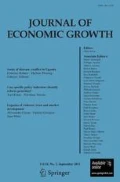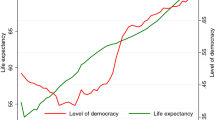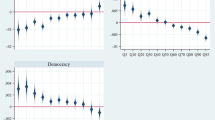Abstract
Growth and democracy (subjective indexes of political freedom) are analyzed for a panel of about 100 countries from 1960 to 1990. The favorable effects on growth include maintenance of the rule of law, free markets, small government consumption, and high human capital. Once these kinds of variables and the initial level of real per capita GDP are held constant, the overall effect of democracy on growth is weakly negative. There is a suggestion of a nonlinear relationship in which more democracy enhances growth at low levels of political freedom but depresses growth when a moderate level of freedom has already been attained. Improvements in the standard of living—measured by GDP, health status, and education—substantially raise the probability that political freedoms will grow. These results allow for predictions about which countries will become more or less democratic over time.
Similar content being viewed by others
References
Alesina, Alberto, and Roberto Perotti. (1993). “Income Distribution, Political Instability, and Investment.” Working paper 4486, National Bureau of Economic Research, October.
Barro, Robert J. (1991). “Economic Growth in a Cross Section of Countries.” Quarterly Journal of Economics 106, 407–433.
Barro, Robert J., and Jong-Wha Lee. (1994). “Sources of Economic Growth.” Carnegie-Rochester Conference Series on Public Policy 40, 1–46.
Barro, Robert J., and Xavier Sala-i-Martin. (1995a). Economic Growth. New York: McGraw-Hill.
Barro, Robert J., and Xavier Sala-i-Martin. (1995b). “Technological Diffusion, Convergence, and Growth.” Working paper 5151, National Bureau of Economic Research (June).
Becker, Gary S., and Robert J. Barro. (1988). “A Reformulation of the Economic Theory of Fertility.” Quarterly Journal of Economics 103, 1–25.
Behrman, Jere R. (1990). “Women's Schooling and Nonmarket Productivity: A Survey and a Reappraisal.” Unpublished paper, University of Pennsylvania.
Benhabib, Jess, and Mark M. Spiegel. (1993). “The Role of Human Capital and Political Instability in Economic Development.” Unpublished paper, New York University.
Blömstrom, Magnus, Robert E. Lipsey, and Mario Zejan. (1993). “Is Fixed Investment the Key to Economic Growth?” Working paper 4436, National Bureau of Economic Research, August.
Bollen, Kenneth A. (1990). “Political Democracy: Conceptual and Measurement Traps.” Studies in Comparative International Development, 7–24.
Caballe, Jordi, and Manuel S. Santos. (1993). “On Endogenous Growth with Physical and Human Capital.” Journal of Political Economy 101, 1042–1067.
Cass, David. (1965). “Optimum Growth in an Aggregative Model of Capital Accumulation.” Review of Economic Studies 32, 233–240.
Delong, J. Bradford, and Lawrence H. Summers. (1991). “Equipment Investment and Economic Growth.” Quarterly Journal of Economics 106, 445–502.
Friedman, Milton. (1962). Capitalism and Freedom. Chicago: University of Chicago Press.
Gastil, Raymond D. (1991). “The Comparative Survey of Freedom: Experiences and Suggestions.” In Alex Inkeles (ed.), On Measuring Democracy. New Brunswick, NJ: Transaction Publishers.
Gastil, Raymond D., et al. (1982–1983 and other years). Freedom in the World. Westport, CT: Greenwood Press.
Helliwell, John F. (1994). “Empirical Linkages Between Democracy and Economic Growth.” British Journal of Political Science 24, 225–248.
Huber, Evelyne, Dietrich Rueschemeyer, and John D. Stephens. (1993). “The Impact of Economic Development on Democracy.” Journal of Economic Perspectives 7, 71–85.
Inkeles, Alex. (1991). On Measuring Democracy. New Brunswick, NJ: Transaction Publishers.
Jain, S. (1975). Size Distribution of Income: A Compilation of Data. Washington, DC: World Bank.
Knack, Stephen, and Philip Keefer. (1994). “Institutions and Economic Performance: Cross-Country Tests Using Alternative Institutional Measures.” Unpublished paper, American University, February.
Koopmans, Tjalling C. (1965). “On the Concept of Optimal Economic Growth.” In The Econometric Approach to Development Planning. Amsterdam: North Holland.
Kormendi, Roger C., and Philip G. Meguire. (1985). “Macroeconomic Determinants of Growth.” Journal of Monetary Economics 16, 141–163.
Lecaillon, Jacques, et al. (1984). Income Distribution and Economic Development. Geneva: International Labor Office.
Lipset, Seymour Martin. (1959). “Some Social Requisites of Democracy: Economic Development and Political Legitimacy.” American Political Science Review 53, 69–105.
Lipset, Seymour Martin. (1994). “The Social Requisites of Democracy Revisited.” American Sociological Review 59, 1–22.
Lipset, Seymour Martin, Kyoung-Ryung Seong, and John Charles Torres. (1993). “A Comparative Analysis of the Social Requisites of Democracy.” International Social Science Journal 45, 155–175.
Lucas, Robert E., Jr. (1988). “On the Mechanics of Economic Development.” Journal of Monetary Economics 22, 3–42.
Mankiw, N. Gregory, David Romer, and David N. Weil (1992). “A Contribution to the Empirics of Economic Growth.” Quarterly Journal of Economics 107, 407–437.
Mulligan, Casey B., and Xavier Sala-i-Martin. (1993). “Transitional Dynamics in Two-Sector Models of Endogenous Growth.” Quarterly Journal of Economics 108, 737–773.
Nelson, Richard R., and Edmund S. Phelps. (1966). “Investment in Humans, Technological Diffusion, and Economic Growth.” American Economic Review 56, 69–75.
Perotti, Roberto. (1996). “Income Distribution, Democracy, and Growth.” Journal of Economic Growth 1. Forthcoming.
Przeworski, Adam, and Fernando Limongi. (1993). “Political Regimes and Economic Growth.” Journal of Economic Perspectives 7, 51–69.
Putman, Robert D., with Robert Leonardi and Raffaella Y. Nanetti. (1993). Making Democracy Work, Civic Traditions in Modern Italy. Princeton, NJ: Princeton University Press.
Ramsey, Frank. (1928). “A Mathematical Theory of Saving.” Economic Journal 38, 543–559.
Rebelo, Sergio. (1991). “Long-Run Policy Analysis and Long-Run Growth.” Journal of Political Economy 99, 500–521.
Sah, Raaj K. (1991). “Fallibility in Human Organizations and Political Systems.” Journal of Economic Perspectives 5, 67–88.
Schultz, T. Paul. (1989). “Returns to Women's Education.” PHRWD background paper 89/001, The World Bank, Population, Health, and Nutrition Department, Washington, DC.
Schwarz, Gerhard. (1992). “Democracy and Market-Oriented Reform: A Love-Hate Relationship?” Economic Education Bulletin 32.
Scully, Gerald W. (1988). “The Institutional Framework and Economic Development.” Journal of Political Economy 96, 652–662.
Sirowy, Larry, and Alex Inkeles. (1990). “The Effects of Democracy on Economic Growth and Inequality: A Review.” Studies in Comparative International Development 25, 126–157.
Solow, Robert M. (1956). “A Contribution to the Theory of Economic Growth.” Quarterly Journal of Economics 70, 65–94.
Summers, Robert, and Alan Heston. (1991). “The Penn World Table (Mark 5): An Expanded Set of International Comparisons, 1950–1988.” Quarterly Journal of Economics 106, 327–368.
Summers, Robert, and Alan Heston. (1993). “Penn World Tables, Version 5.5.” Available on diskette from the National Bureau of Economic Research, Cambridge, MA.
Swan, Trevor W. (1965). “Economic Growth and Capital Accumulation.” Economic Record 32, 334–361.
Tocqueville, Alexis de. (1835). Democracy in America. Translated by Henry Reeve. London: Saunders & Otley.




